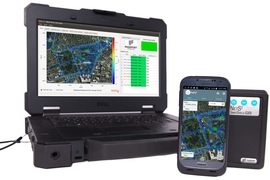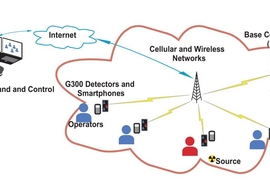In response to the terrorist attacks of September 11, 2001, the U.S. government founded the Department of Homeland Security (DHS) to prevent terrorist attacks on American soil. Among other things, the DHS increased screening of cargo coming into the country.
At the same time at MIT, the terrorist attacks gave rise to a company dedicated to helping DHS — and, ultimately, other governments and organizations worldwide — better detect nuclear and other threats at borders and seaports.
Launched in 2002, Passport Systems developed a scanner, backed by decades of MIT research, that can automatically “fingerprint” radioactive or other suspicious material through a truck, cargo container, or other concealed package, and alert authorities immediately.
Today, Passport — co-founded by MIT physics professor emeritus William Bertozzi — has two commercial scanners: the cargo scanner, a facility used at borders and seaports; and a wireless radiation-monitoring system used at, for example, public events.
Passport’s cargo scanner, called SmartScan, inspects trucks carrying cargo and automatically identifies any radioactive material or “actinides” (radioactive elements) that may signal a dirty bomb, weapon of mass destruction, or explosive. The scanner can also catch contraband such as drugs, tobacco, and firearms. This year, under a contract issued by DHS’s Domestic Nuclear Detection Office, Passport deployed its first SmartScan inspection facility at the Port of Boston’s Conley Container Terminal.
Cargo scanning today relies primarily on high-powered X-rays, which provide a two-dimensional projection of shapes of objects inside containers. Denser objects, which could harbor nuclear threats or contraband, are further investigated by opening the container. Opening and inspecting each suspicious container can take hours and could be dangerous.
Passport’s cargo scanners, on the other hand, offer precision scanning in minutes, without ever opening a container, says Bertozzi, now Passport’s scientific advisor and a member of its board of directors. “In about 30 seconds, we can scan a container and provide a three-dimensional map of [the materials inside the cargo]. This information clears the container or alerts you to a region that needs to be examined more carefully. In another 15 seconds, our scanner will tell you whether there’s an actinide there. In another half a minute, we can tell you what actinide it is, and if it’s a bomb,” he says.
Passport’s handheld system, called SmartShield, is a network of small gamma-radiation detectors, about the size of a deck of cards, that collects radiation data in real-time and wirelessly connects to smartphones. Typically, law enforcement and first responders wear the detectors on their belts and carry the phones, while walking around and collecting data on background radiation. If a detector identifies gamma radiation, it sends an alert to all other smartphones in the network, as well as a central command station, and displays the GPS coordinates to first responders.
SmartShield was trialed at last year’s NASCAR race in New Hampshire, this year’s NCAA Final Four Men’s Basketball Championship in Texas, and other major events in the nation.
“Fingerprinting” actinides
Passport’s SmartScan facility at the Port of Boston is a tunnel about 176 feet long, resembling a drive-through car wash. Trucks carrying land and sea cargo containers are pulled through slowly on a conveyer belt, and scanned by a massive scanner attached to the tunnel’s entrance. This scanner combines conventional high-resolution X-rays and other passive radiation detection methods with scanning techniques pioneered by Bertozzi at the MIT Laboratory for Nuclear Science and by Passport.
As a truck passes through the scanner, Passport’s custom EZ 3-D scanning method generates three-dimensional images of a material based on the effective atomic number — called “effective Z” — which could indicate explosives. To do so, an electron beam produces photons that shoot into the material. The electrons of atoms in the material scatter these photons. The system measures the photon signals to determine any anomalies: Photon signals for high-Z materials such as actinides, for instance, are about 10 times higher than signals from low-Z materials such as common metals. “Because these photon signals are huge and prolific, we can tell you where in the container you have materials that are high effective Z,” Bertozzi says.
But some of these signals are difficult to differentiate, so, if suspicious materials are present, the system automatically conducts refined, secondary scans.
The first technique is Prompt Neutrons from Photofission (PNPF), developed by Bertozzi at MIT in the 1960s. A photon beam causes the actinide nuclei in the material to fission and emit neutrons, which are measured. If the neutrons are produced over a certain threshold of energy, they’re from an actinide. Then the system uses another technique developed by Bertozzi at MIT, called nuclear resonance fluorescence (NRF), where the photon beam excites the nuclei, which emit gamma rays at distinct energy levels. Measuring those energy levels gives the “fingerprint” of the actinide. “We can tell you if it’s, say, uranium-235, uranium-238, oxygen-17, or carbon-12, because they all have different signals,” Bertozzi says.
Drugs and alcohol have specific “fingerprints” too, as do materials such as salt and chlorine, so the scanner is helpful for detecting contraband. A scanner, for instance, could detect chlorine, sometimes used to make methamphetamine, in a truck full of clothing.
Now, the United Kingdom is seeking the systems to look for items such as untaxed tobacco being smuggled across the border, while other countries are looking for the systems to scan for drugs and alcohol. “It serves a security need, but it also satisfies general customs needs,” says Passport’s CEO, president, and co-founder Robert Ledoux ’78, PhD ’81, who taught physics at MIT until 1990. “That’s made it commercially viable.”
Passport’s SmartShield detectors use standard photon-detection technology to detect gamma rays. But the innovation comes from the network, which offers numerous benefits, Ledoux says. Working together, the scanners can quickly triangulate the location of a threat. Constantly updated radiation data, from multiple detectors being carried around an area, also makes the system as a whole more sensitive. “With each passing sweep, it can better separate naturally occurring radiation in, say, building materials from hazardous nuclear materials,” Ledoux says.
Coming together at MIT
Passport’s story starts in the mid-1990s, when Bertozzi tried bringing his MIT-invented NRF scanning technology to a company that was trying to commercialize baggage-scanning technologies in U.S. airports. Despite successful tests, the company decided the technology was too expensive to scale, especially since airplane bombings weren’t necessarily considered a major threat.
“But then the world changed with 9/11,” Ledoux says.
Suddenly, the newly minted DHS wanted all baggage at airports and every cargo unit at the U.S. border scanned for explosives. X-rays and CT scans were used for luggage, but no quick, accurate scanning techniques existed for cargo containers. “It’s difficult to detect explosives in a small package. Imagine having a 40-foot container filled with thousands of pounds of things, whipping through the supply chain,” Ledoux says.
Seeing that the world was ripe for NRF-based scanners, Bertozzi launched Passport with friend and MIT Sloan School of Management alumnus Gordon Baty ’61, SM ’63, PhD ’67, who is now chair of Passport’s board of directors. They pulled in Ledoux as CEO and set up shop in Ledoux’s home office.
However, although they could prove the technology theoretically, there was nowhere to test it on a large scale. Then one day Ledoux was on MIT’s campus, speaking with a fellow alum about Passport’s testing issues, when the alum pointed to MIT’s High Voltage Research Laboratory, which was supposedly shut down. “We were literally right across the street,” Ledoux says. “So we walked over and rang the doorbell.”
Turns out, the MIT facility was still in use. “It became only the third place in the country that we could do the experiments,” Bertozzi says.
“The world came together at this small lab on MIT’s campus,” Ledoux adds.
Throughout the mid-2000s at MIT, a small team including Bertozzi and Ledoux recorded the unique signals of all actinides. From there, the project grew steadily: In 2007 and 2008, Passport received DHS contracts to test a proof of concept of their cargo scanner, at their headquarters in Billerica. In 2009, Passport received a DHS contract to build their SmartScan system.
The company’s latest DHS contract, issued in 2013, is for building a system that fuses gamma radiation-detection data with video, to track radiation in vehicles traveling at highway speeds.
![“In about 30 seconds, we can scan a container and provide a three-dimensional map of [the materials inside the cargo]. This information clears the container or alerts you to a region that needs to be examined more carefully,” says William Bertozzi, MIT physics professor emeritus and co-founder of Passport Systems.](/sites/default/files/styles/news_article__download/public/download/201606/MIT-Passport-System.jpg?itok=y40Mr8eO)



![“In about 30 seconds, we can scan a container and provide a three-dimensional map of [the materials inside the cargo]. This information clears the container or alerts you to a region that needs to be examined more carefully,” says William Bertozzi, MIT physics professor emeritus and co-founder of Passport Systems.](/sites/default/files/styles/news_article__image_gallery/public/images/201606/MIT-Passport-System_0.jpg?itok=L48kkkMi)









